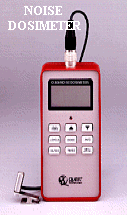Noise Monitoring![]()
![]() If
you are at risk of exposure to excess noise, monitoring should be done in your workplace.
The results of this monitoring will tell you what your exposure is, and
whether you and people who do similar work should be included in a Hearing Conservation
Program. Noise monitoring results are also used to determine when hearing protection
is required to protect you.
If
you are at risk of exposure to excess noise, monitoring should be done in your workplace.
The results of this monitoring will tell you what your exposure is, and
whether you and people who do similar work should be included in a Hearing Conservation
Program. Noise monitoring results are also used to determine when hearing protection
is required to protect you.

![]() If your
exposure is continuous throughout the day (for example, if you spend your day in a noisy
steam plant), it may be only necessary to measure the noise level present in your work
area. However, if you are exposed to varying, intermittent noise levels (such as
numerous types of grounds maintenance or carpentry equipment), you may have to wear a
noise dosimeter (picture on right) for a day to determine your daily noise exposure.
If your
exposure is continuous throughout the day (for example, if you spend your day in a noisy
steam plant), it may be only necessary to measure the noise level present in your work
area. However, if you are exposed to varying, intermittent noise levels (such as
numerous types of grounds maintenance or carpentry equipment), you may have to wear a
noise dosimeter (picture on right) for a day to determine your daily noise exposure.
![]() The
Industrial Hygienist at USC Environmental Health and Safety can conduct this noise
monitoring at the request of your department.
The
Industrial Hygienist at USC Environmental Health and Safety can conduct this noise
monitoring at the request of your department.
![]()